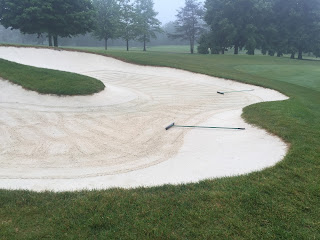Our day
starts at 5:30am, and during the peak summer months we start at 5:00 am and
sometimes even 4:30 am! If anyone wishes
to see the morning push you must be there at 5:30 AM. We live by the slogan, early is on time, and
on time is late!! Assignments vary from mowing greens, collars, fairways,
rough, raking bunkers, changing cups or working on upcoming projects. During
this meeting we discuss job specifics or events (i.e. shotgun starts). This is the
most dedicated and hard-working crew I’ve had the opportunity to work
with! Every person cares about the
playability and aesthetics of Kemper Lakes!
Grounds crew going over daily
assignments
All mowers are ready to go!
Our
bunkers have steep faces to make shots more difficult. Juan is mowing what we
call a “finger” in the bunker. We use a
special piece of equipment called a “hover mower”. This mower, “hovers” along the grass to mow
these tougher areas.
Juan using the “Hover Mower” on a bunker
finger.
One of the
best tools we use on a daily basis is our TDR Soil Moisture Meter. We use this
to monitor soil moisture in the greens.
During peak summer months, this is used to help prevent wilting from
occurring on the greens. In July and
August, we check greens twice daily.
This allows us to keep greens as firm as possible without the
possibility of losing any turf.
And of
course, we try to reward hard work with as much praise as possible! The guys are excellent cooks, they make an
outstanding carne asada!





















